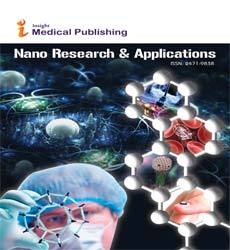Medical Nanotechnology: Small Technology and Big Impact in Oncology!
Farid Menaa
Farid Menaa*
Director R&D&I, International Consulting Expert in Healthcare and Biosystems, France
- *Corresponding Author:
- Farid Menaa
Director R&D&I, International Consulting Expert in Healthcare and Biosystems, France
Tel: +33 788 770 475
E-mail: dr.fmenaa@gmail.com
Received date: July 30, 2015; Accepted date: August 02, 2015; Published date: September 08, 2015
Citation: Menaa F. Medical Nanotechnology: Small Technology and Big Impact in Oncology! Nano Res Appl. 2015, 1:1.
Editorial
Nowadays, cancer remains one of the main causes of death in the world. The utilization of nanoparticles for diagnosis and treatment in all cancers has raised research interest and funding in the area of medical nanotechnology. The daily increasing numbers of publications in nanotechnology report various promising applications from approaches that include nano-drug and gene delivery, molecular targeting, photothermal and photodynamic therapy, as well as magnetic localization/imaging, which are undoubtedly all important in oncology. Indeed, challenging issues in cancer care include more precise/accurate, efficient, faster and earlier diagnosis, prognosis and therapy. Cancer nanotechnology offers solutions that could identify and target more effectively and specifically cancer cells by delivering nano-drugs with lower undesired side-effects such as systemic toxicity than conventional medicines and agents (e.g., isotopes, dyes) [1,2].
For instance, various types of cancers such as pancreatic cancer are usually diagnosed at the advanced stages, respond poorly to the available chemotherapeutics and lead to high mortality rate. Selective delivery of therapeutics to their cellular targets, without side effects, is the foremost objective of current investigations. Novel drugs delivery systems including (hybrid-)nanoparticles, liposomes, quantum dots, micelles and drug conjugates offer hopes in the management of cancers [3,2].
Interestingly, thanks to its unique physical and chemical properties, graphene and its main derivatives (i.e., graphene oxide and reduced graphene) have also attracted tremendous interest in cancer theranostics (i.e., the use of imaging such as ultrasonography, positron electron tomography, fluorescent imaging, Spectroscopy combined to one or more therapeutic modalities) [4-6].
Ongoing and future studies should aim to investigate more deeply the impact of the tumor microenvironment on the distribution and effects of nanoparticles and how these nanoparticles reversely affect the tumor microenvironment. Indeed, while enhanced permeability and retention effect (EPR) promotes nanoparticle extravasation, the abnormal tumor vasculature, high interstitial pressure and dense stroma structure limit homogeneous intratumoral distribution of nanoparticles and compromise their imaging and therapeutic effect(s). Moreover, heterogeneous distribution of nanoparticles in nontumor-stroma cells damages the nontumor cells, and interferes with tumor-stroma crosstalk. This can lead to inhibition of tumor progression, but can also paradoxically induce acquired resistance and facilitate tumor cell proliferation and metastasis [7].
Eventually, nanotheranostic strategies offer a way to accomplish evidence-based personalized medicine (EBPM) [5,8] and any of them should be carefully designed, calibrated/standardized for a specific theranostic objective in order to obtain more significant clinical impacts [9,10].
References
- Menaa F (2013) When Pharma Meets Nano or The Emerging Era of Nano-Pharmaceuticals. Pharmaceut Anal Acta 4: 223.
- Menaa F, Menaa B (2012) Development of mitotane lipid nanocarriers and enantiomers: two-in-one solution to efficiently treat adreno-cortical carcinoma. Curr Med Chem 19: 5854-5862.
- Lytton-Jean AK, Kauffman KJ, Kaczmarek JC, Langer R (2015) Cancer nanotherapeutics in clinical trials. Cancer Treat Res 166: 293-322.
- Orecchioni M, Cabizza R, Bianco A, Delogu LG (2015) Graphene as cancer theranostic tool: progress and future challenges. Theranostics 5: 710-723.
- Menaa F, Abdelghani A, Menaa B (2014) Graphene nanomaterials as biocompatible and conductive scaffolds for stem cells: impact for tissue engineering and regenerative medicine. J Tissue Eng Regen Med .
- Menaa F, Menaa B, Sharts O (2011) Development of carbon-fluorine spectroscopy for pharmaceutical and biomedical applications. Faraday Discuss 149: 269-278.
- Miao L, Huang L (2015) Exploring the tumor microenvironment with nanoparticles. Cancer Treat Res 166: 193-226.
- Sharma S (2014) Nanotheranostics in evidence based personalized medicine. Curr Drug Targets 15: 915-930.
- Perry JL, Kai MP, Reuter KG, Bowerman C, Christopher Luft J, et al. (2015) Calibration-quality cancer nanotherapeutics. Cancer Treat Res 166: 275-291.
- Menaa F (2014) Exciting (G)raph’ N Medicine and Pharmacy: A (G)ood Point Toward Integrative, Translational, Regenerative and Personalized Medicine!. J Nanomater Mol Nanotechnol S1: e002.
Open Access Journals
- Aquaculture & Veterinary Science
- Chemistry & Chemical Sciences
- Clinical Sciences
- Engineering
- General Science
- Genetics & Molecular Biology
- Health Care & Nursing
- Immunology & Microbiology
- Materials Science
- Mathematics & Physics
- Medical Sciences
- Neurology & Psychiatry
- Oncology & Cancer Science
- Pharmaceutical Sciences
